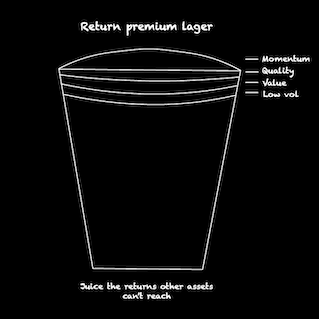Oh god, what now? What now is Section 899 of the One Big Beautiful Bill – Trump’s monster-truck ‘tax and spend’ act currently bouncing around the halls of Congress.
Section 899 has been dubbed a ‘revenge tax’ because it targets individuals, corporations, and governments of foreign countries who are deemed to be hitting US entities with ‘unfair foreign taxes’.
Foreign countries like China, North Korea, and that island where all the tariff-loving penguins live, right?
Not necessarily. Quite possibly foreign lands like the UK, the EU, Australia and Japan. Plus anyone else who perhaps had Big Tech in mind when they drew up undertaxed profits rules (UTPRs), digital services taxes (DSTs), or diverted profits taxes (DPTs).
How does Section 899 affect ME?
Yes, I hear you.
The most likely impact at the time of writing is that you, an individual resident in a major US trading partner and ally, quietly building up your nest egg chock full of American assets, could be on the hook to pay a higher rate of US withholding tax (WHT).
There could be other spillover effects too but I’m going to concentrate on the most immediate – and talk about how you could mitigate the worst, should it happen.
Currently, withholding tax is due on income paid by US assets to overseas owners.
Many Monevator readers already pay withholding taxes on US equities and bonds 1, although that’s not always apparent.
For example, a non-US domiciled fund will pay withholding tax on your US income before distributing the balance as dividends or interest (or reinvesting the cash back into the fund.)
That’s so much background. The nub of the problem is that anyone paying US withholding tax – whether directly or indirectly – could be in the firing line.
WHT? WTF more like
The main rate of US withholding tax is 30%. It’s levied on income, not capital gains.
Right now, you’re typically in for 15% WHT on US securities held via an Irish-domiciled fund or ETF. You get 50%-off the main rate due to a Double Taxation Agreement (DTA) that exists between the United States and Ireland. 2
UK domiciled funds also qualify for the 15% withholding tax rate. Mighty Blighty has a deal with Uncle Sam, too.
Fund managers have to actively claim the rebate, which I imagine is much like wangling a gift voucher out of your mobile phone provider: “Only valid when accompanied by an original receipt, recent dental X-ray, and proof of being heir to the throne…”
It’s commonly accepted that Irish ETFs only pay 15% WHT but it may be worth checking the specifics if you invest in another type of fund. 3
Got a portfolio of individual US stocks? Then fill in a W-8BEN form to reduce your WHT rate to 15%.
Ideally hold your portfolio of Made In America assets in a pension or SIPP. Choose the right platform and your SIPP scoops a 0% rate – no paperwork required.
What are the withholding tax hikes proposed under Section 899?
Section 899 goes from bad to worse depending on which version of the legislation we’re talking about.
Currently, one version has been passed by the US House of Representatives and another is due to be voted on by the Senate.
It’s worth saying that the entire bill is still subject to amendment as it journeys through Congress. Section 899 is not yet set in stone.
But here’s where we’re at:
| Section 899 WHT | House version | Senate version |
| WHT rate after phase-in | 50% | 15% to 45% depending on existing treaty rates |
| Phased rise | 5% per year | 5% per year |
| DTA discount effect | All rates rise 5% per year until the 50% cap is reached. | DTAs cushion the blow e.g. Existing 0% rate rises to max 15%. 30% rate rises to max 45%. |
A quick example may help you better understand these proposals.
Let’s say you (or your fund) currently pays a 15% WHT rate on US dividends. In this case the House plan will demand 50% of your income in year seven after Section 899 is invoked.
That’s the ceiling rate. You’ll pay 50% from there on in (as will everyone else once the 5% per year phased hikes have done their work.)
The Senate version still screws you, but it’s gentler, possibly more classy. The lovely senators jack the rate three times and respect your DTAs.
F’r instance, a 15% payer caps out at 30% after three years.
It’s still less than ideal.
How bad?
You can estimate your loss of return by multiplying your investment’s dividend yield by your WHT percentage.
The S&P 500’s dividend yield is 1.3% according to the current S&P Dow Jones factsheet. So your loss to withholding tax is approximately:
| WHT rate | 0% | 15% | 30% | 45% | 50% |
| Loss of return | 0% | -0.2% | -0.39% | -0.59 | -0.65% |
Thus if you pay 15% WHT now, your dividend return is reduced from around 1.3% to 1.1%
The House’s 50% revenge rate would cut your dividends in half. You’d be losing 0.65% based on the current yield.
That will add up over time.
Moreover, the S&P 500’s yield is near its historic low. An average yield of 1.5% to 2% is more typical.
The effect is worse still if you’re invested in higher-yielding stocks, such as a US dividend growth strategy.
Run away?
It’s important we don’t lose our heads.
Nobody wants to lose halve their dividend return, but here’s what it would have looked like (red line) compared to the returns you actually made investing in the S&P 500 this past decade while paying 15% WHT (blue line).

Nominal USD annual total return data from Aswath Damodaran. Fund costs not included. June 2025.
In the worst-case 50% WHT scenario you’d have booked a 12.1% annualised return instead of a 12.7% annualised return over ten years. 4
As I say: not great. It does hurt!
But you would still have been better off investing in US equities versus the World ex-US over this period, even if ultimately exposed to the hardcore version of Section 899.
Tax tail meet investment dog
Of course we can argue that the S&P 500 would have been less attractive to global investors, or that US holdings will henceforth come with greater political risk attached…
I’d sign up to all of that.
But pre-emptively moving now to down-weight the US in our portfolios solely on the basis of Section 899 looks premature to me.
For a start the US is likely to remain one of the most dynamic markets in the world and trying to guess what will happen next is a fools’ errand. Perhaps now more than ever.
Secondly, there’s a great way to get around Section 899 – SHOULD IT HAPPEN. (Sorry about the all-caps, just channelling my inner Trump there.)
The work around
There are #reasons to think you won’t have to face the revenge tax even if the bill passes.
Synthetic ETFs don’t have to pay US WHT. They duck the tax by using a financial derivative to pay the index return – as opposed to the normie approach of actually holding the shares that comprise the index.
This isn’t regarded as a tax dodge.
Synthetic S&P 500 ETFs have been operating since 2010. They’ve accumulated billions in assets under management. They’re not in the cross-hairs of the IRS.
iShares, Xtrackers, and Amundi have all launched new synthetic S&P 500 ETFs in the last few years as word spread that their withholding tax advantage gave them the edge over physical ETFs.
World and global synthetic ETFs are available, too.
Sure, the US government could level the playing field later.
But for now this is an obvious get-out.
Are US Treasuries affected?
In a word, “No.” In three words, “No, for now.”
The Senate bill clarified that even the House formulation doesn’t intend to go after foreigners who are helping to fund the US deficit by owning US fixed income.
So we can rest easy on that.
Even if some maniac flips out and changes their mind then the obvious remedy would be to forget Treasuries and hold gilts instead.
Negotiation tool
(Ooh, I’m pleased with that one. Just when I thought I was all out of nicknames for Trump!)
Section 899 is intended as a tool for negotiation. It would cease to apply in the tax year after a country drops whatever tax displeases the US Treasury Secretary.
From that perspective, the phased 5% hikes are a useful way of turning the tax thumb screws: “Don’t make me do this.”
Of course, the UK or the EU may not cave. (Well, we probably will. But they may not.)
I’d need to consult a tax lawyer to understand what would happen if the UK quietly mothballed the offending taxes while Ireland didn’t.
Irish-domiciled ETFs are typically structured as Irish corporations and pay withholding tax at the fund level, so UK domiciled funds could gain a competitive advantage in that scenario.
There’s also a Section 899 exemption for ‘United States-owned’ foreign corporations. This applies if more than 50% of the entity’s vote or value is held by US persons.
Could that mean we’d be protected from Section 899 by funds from US firms like iShares, Vanguard, or State Street? Again, I’m not an international tax lawyer on a MAGA retainer. (Though I wish I was paid like one).
What’s more, a cavalcade of financial industry special interests and lobbyists is apparently working to water down the provisions as they stand. 5
Finally, the One Big Beautiful Bill Act could fail to pass into law. That does happen in Congress. So this is far from a done deal.
Finally, finally, we could club together and send Trump a new Statue of Liberty. But with his face. Made out of gold. He’d like that.
Take it steady,
The Accumulator
P.S. ‘Section 891’ already exists in US law to punish foreigners adjudged to impose unfair taxes on US citizens and interests. It’s never been invoked. Apparently Section 899 is thought more likely to be implemented (if it becomes law) because it’s not as harsh.
P.P.S. Other Section 899 provisions could adversely impact the profits of non-US companies. But that doesn’t seem worth getting into yet given all the uncertainties. Also, the damage estimates seem small, and companies could legally shape-shift their ownership structure to avoid the incoming.
- Lots of other countries levy similar withholding taxes but we’re not concerned with that here.[↩]
- Remember it’s the fund that pays. While you don’t incur withholding tax on dividends paid directly to you by Irish-based funds and ETFs, that’s because they’ve already settled accounts with Uncle Sam before you get a sniff.[↩]
- Contact the fund manager or look in the annual report. Find the section that details the amount of overseas dividends received and tax paid. Divide the tax paid by the dividend amount. Multiply by 100 to discover the effective withholding tax rate. Note, this will only give you the effective US withholding tax rate if the fund invests 100% in US assets.[↩]
- Nominal USD returns.[↩]
- Hard to believe I’m cheering on this crew.[↩]



